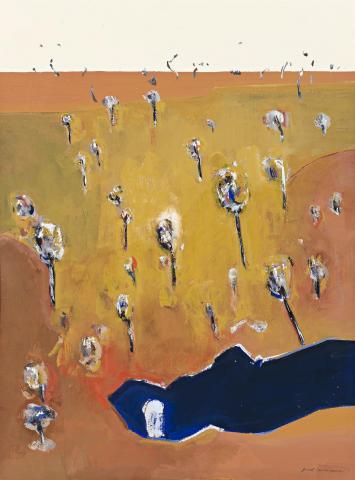WATERPOND IN A LANDSCAPE, 1966
FRED WILLIAMS
gouache on paper
73.5 x 54.0 cm
signed lower right: Fred Williams
Private collection, Melbourne
Deutscher~Menzies, Sydney, 16 March 2005, lot 12
Private collection, Brisbane
Waterpond in a Landscape II, 1966, oil on canvas, 152.5 x 122.0 cm, private collection, Melbourne, illus. in McCaughey, P., Fred Williams, Bay Books, Sydney, 1980, p. 175
You Yangs Pond, 1967, gouache, 69.7 x 57.4 cm, collection of the National Gallery of Victoria, Melbourne
Fred Williams often worked in series, oil paintings, gouaches and etchings following each other close in subject and creative exploration. Waterpond in a Landscape 1966 is a brilliant example, being one of three on the subject and among his finest watercolours. A similarly titled gouache was sold last August, and You Yangs Pond 1967 is in the collection of the National Gallery of Victoria, Melbourne. They differ from each other chiefly in the expanse of the landscape. The furthest view is provided by that in the National Gallery of Victoria. Our painting occupies the middle ground. The subject and pond motif were explored earlier in the impressive You Yangs Pond etchings of 1963-64. There are also three major oil paintings of 1966, Waterpond in a Landscape I to III, which are similar in approach to the gouaches.1 In acknowledgement of their outstanding quality, two of these large landscapes were held in the prestigious collections of Rudy Komon and James Fairfax. What catches the eye most in the oils and gouaches is their striking colour-drama combined with the engaging feeling of immediacy. Carefully composed as they are, their presentation has that visionary quality of seeing something for the first time, a fascination close to wonderment. This extends through the interplay between pictorial flatness and the ever-subtle illusion of vastness. Add the sensuous milky textures and fluidity of the rich pigments in the gouaches, and you have a feast of visual delight.
The mid-sixties were a particularly fruitful time in Williams's art, of increased variety allied to an increasing abstraction. This is seen in our gouache, Waterpond in a Landscape 1966.While based on the water pond at Lysterfield in country Victoria, the absence of the artifice of Western perspective allows greater freedom of invention in the play between breadth and intimacy in the landscape. It transcends mere verisimilitude; yet is redolent of the sun-baked Australian landscape. In a captivating fusion of reality and abstraction, bold areas of colour and detailed features conjure up the fascination of a non-figurative work while remaining distinctly Australian in imagery and atmosphere. Gum trees sport across fields of ochre, and surfaces are enlivened by the texture of the paint and colour contrasts, intruded upon by the dark depths of the pond. Irregularity of contours adds further lively interest. In 1966 James Gleeson wrote, 'Williams has made the wooded hills and plains of Victoria his special province, and so persuasive are his images that we cannot look at the real thing except in the terms he has set down for us in paint.'2 This gouache and the others in the series are further testimony to the originality of his vision.
1. Illus. in McCaughey, P., Fred Williams, Bay Books, Sydney, 1980, pp. 174-176
2. Gleeson, J., 'Williams is at his best', Sun, Sydney, 12 October 1966
DAVID THOMAS
